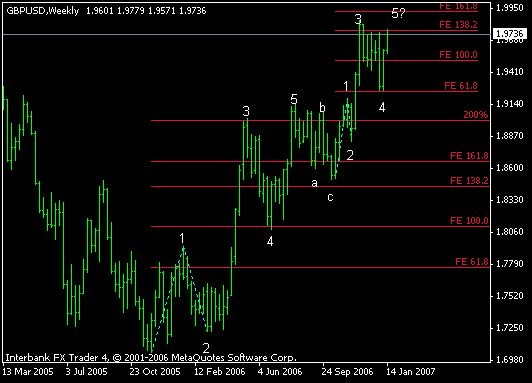<table border="0" cellpadding="0" cellspacing="0" width="575"><tbody><tr><td valign="top">In the Zigzag
</td> </tr> <tr> <td width="6">
</td> <td>
</td> <td height="12"> </td> </tr> </tbody></table> <table border="0" cellpadding="0" cellspacing="0" width="575"><tbody><tr><td width="6">
</td> <td class="EC_article" valign="top">OK. Close your eyes. Visualize what a typical zigzag shape looks like. Now, what images come to mind?
Lightening bolts – Sewing stitches – Zippers – The way grandma walks after one too many eggnogs.
Have an Elliott Wave analyst do the same exact exercise and chances are, ONE image and one image only will appear: Opportunity.
As for why – well, nothing explains that better than this labeled price chart from the December 8 Daily Futures Junctures Weekly Wrap-Up. Have a look-see.
http://www.elliottwave.com/images/ez...2012-13-06.gif
Voila! The very first pattern that pops out is the crisscross whish wash unfolding in Intermediate wave (4). That, my friends, is the very familiar shape known as a "Triple ZIGZAG."
Who here didn't see THAT one coming?
As for a formal definition, Elliott Wave Principle – Key To Market Behavior is an open book:
"A single zigzag is a simple three-wave pattern labeled A-B-C whereby the top of wave B NEVER moves beyond the start of wave A. Occasionally zigzags will occur twice or at most, three times in succession, particularly when the first zigzag falls short of a normal target. In these cases, each zigzag is separated by an intervening "X," producing what is called a double or triple zigzag. These formations are analogous to the extension of an impulse wave but are less common."
Now, as you can see from DFJ's close-up – which reflects the near-term price action underway in a major commodity market – once the triple zigzag is complete, Primary Wave 3 is set to begin.
Let's put it this way – if impulse patterns were snowmen, waves one and five would be FROSTY. Wave three… … … well … … … It would be the legendary Yeti, the Abominable snowman of the Himalayas, footprint the size of a four-door Sedan.
As a matter of fact, Ralph Nelson Elliott himself described third waves as "Wonders to Behold," which means, in plain English: This grain market is set to GAIN, big time.
The best part is, you can see DFJ's complete chart of this market along with 18 others in the December 8 Weekly Wrap-Up publication via a risk-free subscription today.
(Editor's Note: To read the Dec. 8 Daily Future Junctures, once you've subscribed, open the current DFJ and click on the Archives tab. You'll find plenty of other recently-identified opportunities in the Archives, too.)
</td></tr></tbody></table>
</td> </tr> <tr> <td width="6">
</td> <td>
By Nico Isaac
</td> </tr> <tr height="12"> <td height="12" width="6"></td> <td height="12"> </td> </tr> </tbody></table> <table border="0" cellpadding="0" cellspacing="0" width="575"><tbody><tr><td width="6">
</td> <td class="EC_article" valign="top">OK. Close your eyes. Visualize what a typical zigzag shape looks like. Now, what images come to mind?
Lightening bolts – Sewing stitches – Zippers – The way grandma walks after one too many eggnogs.
Have an Elliott Wave analyst do the same exact exercise and chances are, ONE image and one image only will appear: Opportunity.
As for why – well, nothing explains that better than this labeled price chart from the December 8 Daily Futures Junctures Weekly Wrap-Up. Have a look-see.
http://www.elliottwave.com/images/ez...2012-13-06.gif
Voila! The very first pattern that pops out is the crisscross whish wash unfolding in Intermediate wave (4). That, my friends, is the very familiar shape known as a "Triple ZIGZAG."
Who here didn't see THAT one coming?
As for a formal definition, Elliott Wave Principle – Key To Market Behavior is an open book:
"A single zigzag is a simple three-wave pattern labeled A-B-C whereby the top of wave B NEVER moves beyond the start of wave A. Occasionally zigzags will occur twice or at most, three times in succession, particularly when the first zigzag falls short of a normal target. In these cases, each zigzag is separated by an intervening "X," producing what is called a double or triple zigzag. These formations are analogous to the extension of an impulse wave but are less common."
Now, as you can see from DFJ's close-up – which reflects the near-term price action underway in a major commodity market – once the triple zigzag is complete, Primary Wave 3 is set to begin.
Let's put it this way – if impulse patterns were snowmen, waves one and five would be FROSTY. Wave three… … … well … … … It would be the legendary Yeti, the Abominable snowman of the Himalayas, footprint the size of a four-door Sedan.
As a matter of fact, Ralph Nelson Elliott himself described third waves as "Wonders to Behold," which means, in plain English: This grain market is set to GAIN, big time.
The best part is, you can see DFJ's complete chart of this market along with 18 others in the December 8 Weekly Wrap-Up publication via a risk-free subscription today.
(Editor's Note: To read the Dec. 8 Daily Future Junctures, once you've subscribed, open the current DFJ and click on the Archives tab. You'll find plenty of other recently-identified opportunities in the Archives, too.)
</td></tr></tbody></table>
